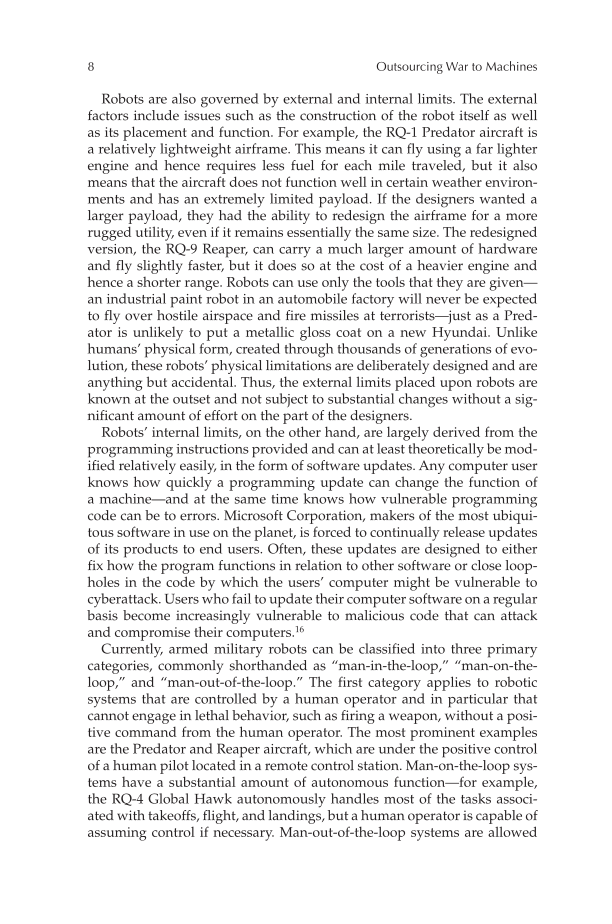8 Outsourcing War to Machines Robots are also governed by external and internal limits. The external factors include issues such as the construction of the robot itself as well as its placement and function. For example, the RQ-1 Predator aircraft is a relatively lightweight airframe. This means it can fly using a far lighter engine and hence requires less fuel for each mile traveled, but it also means that the aircraft does not function well in certain weather environ- ments and has an extremely limited payload. If the designers wanted a larger payload, they had the ability to redesign the airframe for a more rugged utility, even if it remains essentially the same size. The redesigned version, the RQ-9 Reaper, can carry a much larger amount of hardware and fly slightly faster, but it does so at the cost of a heavier engine and hence a shorter range. Robots can use only the tools that they are given— an industrial paint robot in an automobile factory will never be expected to fly over hostile airspace and fire missiles at terrorists—just as a Pred- ator is unlikely to put a metallic gloss coat on a new Hyundai. Unlike humans’ physical form, created through thousands of generations of evo- lution, these robots’ physical limitations are deliberately designed and are anything but accidental. Thus, the external limits placed upon robots are known at the outset and not subject to substantial changes without a sig- nificant amount of effort on the part of the designers. Robots’ internal limits, on the other hand, are largely derived from the programming instructions provided and can at least theoretically be mod- ified relatively easily, in the form of software updates. Any computer user knows how quickly a programming update can change the function of a machine—and at the same time knows how vulnerable programming code can be to errors. Microsoft Corporation, makers of the most ubiqui- tous software in use on the planet, is forced to continually release updates of its products to end users. Often, these updates are designed to either fix how the program functions in relation to other software or close loop- holes in the code by which the users’ computer might be vulnerable to cyberattack. Users who fail to update their computer software on a regular basis become increasingly vulnerable to malicious code that can attack and compromise their computers.16 Currently, armed military robots can be classified into three primary categories, commonly shorthanded as “man-in-the-loop,” “man-on-the- loop,” and “man-out-of-the-loop.” The first category applies to robotic systems that are controlled by a human operator and in particular that cannot engage in lethal behavior, such as firing a weapon, without a posi- tive command from the human operator. The most prominent examples are the Predator and Reaper aircraft, which are under the positive control of a human pilot located in a remote control station. Man-on-the-loop sys- tems have a substantial amount of autonomous function—for example, the RQ-4 Global Hawk autonomously handles most of the tasks associ- ated with takeoffs, flight, and landings, but a human operator is capable of assuming control if necessary. Man-out-of-the-loop systems are allowed
Document Details My Account Print multiple pages
Print
You have printed 0 times in the last 24 hours.
Your print count will reset on at .
You may print 0 more time(s) before then.
You may print a maximum of 0 pages at a time.
























































































































































































































































































